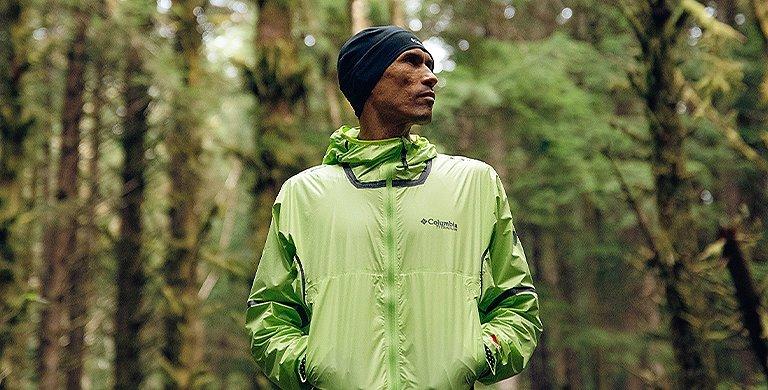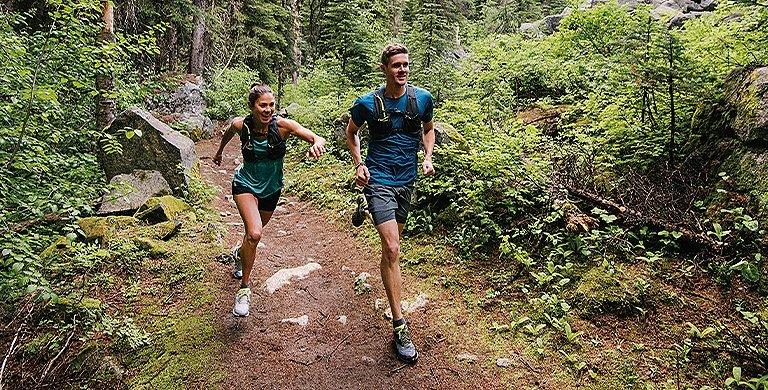HOW TO TRAIL RUN
Caroline Freslon, 41, is a true inspiration: having never run further than 12km, a friend entered her into the Saintélyon - a 68km race - which not only did she complete, she came third. “No one had expected this kind of result,” she remembers. “My body ached for two weeks after that but I was stoked.” Freslon was hooked and began running trail races, before eventually starting her own agency, Fifth Element organising mountain trail running courses.
Fast forward 11 years and it’s become a really successful business, she says. “Trail running wasn’t as big as it is now and a lot of people didn’t understand what I did,” she shares. “I’m so glad I never gave up.” In fact, she compares the story of her life to running an ultratrail: “It’s tough, you go through all kinds of stages - from feeling euphoric to feeling super low - but you push through because of the incredible moments you experience and the wonderful people you meet. When all of this is met by success at the end, there’s nothing more gratifying.” With years of experience and a huge passion for trail running, there’s no-one better placed to share their trail running tips. Here’s Freslon’s key pieces of advice:
Fast forward 11 years and it’s become a really successful business, she says. “Trail running wasn’t as big as it is now and a lot of people didn’t understand what I did,” she shares. “I’m so glad I never gave up.” In fact, she compares the story of her life to running an ultratrail: “It’s tough, you go through all kinds of stages - from feeling euphoric to feeling super low - but you push through because of the incredible moments you experience and the wonderful people you meet. When all of this is met by success at the end, there’s nothing more gratifying.” With years of experience and a huge passion for trail running, there’s no-one better placed to share their trail running tips. Here’s Freslon’s key pieces of advice:

EXPLORE YOUR LOCAL AREA AND TAKE IN YOUR SURROUNDINGS
So, what exactly is trail running? Similar to mountain and fell running, trail running mixes running with elements of hiking, usually with some steep gradients thrown in. In its purest form, it’s any run outside in nature that is carried out on an unpaved path. Now, how to start trail running? Well, the simplest way is to lace up your trainers and get outside, exploring your local area for wooded trails or paths. Even in a city, you’re likely to come across a wooded or grassy area with tracks and paths. “I really like trail running because of the incredible feeling of freedom you get,” she explains.
Rather than focusing on distance, Freslon recommends deciding on a length of time for your trail run, which can be adjusted according to the terrain: " In the mountains, I would recommend 2-3 hours for a beginner [and] up to half a day for an experienced road runner."
Formerly a professional rower, Freslon now enjoys a more relaxed approach to her training: “I make a conscious effort to really take the time to enjoy my surroundings. I still really like pushing my limits but I get to choose how I do it.”
Formerly a professional rower, Freslon now enjoys a more relaxed approach to her training: “I make a conscious effort to really take the time to enjoy my surroundings. I still really like pushing my limits but I get to choose how I do it.”
“It’s been really freeing for us,” she says. “Everywhere we go, we can take everything with us. Being able to take our lives around with us is something we’ve always dreamed of and worked so hard for. We just want to see what it’s really like now.”

CHOOSE THE RIGHT KIT
The first piece of trail running kit to get sorted should be a pair of trail running shoes. Freslon advises checking the stability, protection and outsole grip when selecting a pair.
Conditions can change quickly, especially if you’re out in the mountains. Freslon stresses keeping changing conditions in mind and anticipating this when packing kit, especially if you’re tackling mountains.
Freslon’s go-to mountain trail running essentials include:
- Warm and waterproof clothes: one long-sleeve base layer and mid-layer fleece, plus a windproof, waterproof and breathable shell.
- Hydration and nutrition: a minimum of one litre of water and food such as energy bars and dry fruit.
- Phone, ID, money: make sure your phone is fully charged and working. Remember ID and a small amount of cash in case you need to buy anything en route.
- Safety kit: should include an emergency foil blanket, elastic bandage, plasters, disinfectant spray and a head torch.

LISTEN TO NATURE AND RESPECT IT
A vital lesson to remember, especially for trail running beginners, is to listen to and respect nature. “I feel that as time goes by, the elements become increasingly humbling for me,” explains Freslon.
When I take people out in the mountains, I have a duty. I try to anticipate all kinds of scenarios as much as possible.” Listening to signals from nature, such as weather changes, rock falls and wind as well as noting temperature and the technical aspects of the terrain are important, she stresses. “I understand how generous and also dangerous nature can be,” she explains, noting that it’s important to always keep that in mind.



